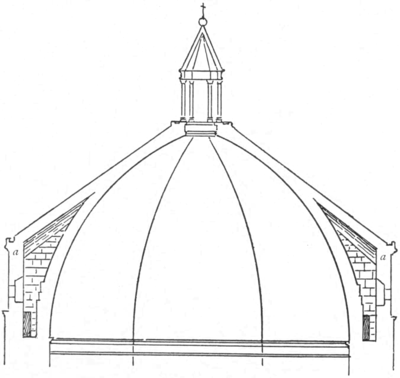safer form in which the vault is made to spring from within the drum, and is thus necessarily, either in part or entirely, hidden from external view.
A remarkable dome of this latter class is that of the Baptistery of Florence, which, though the building has undergone various superficial transformations since its original construction at an early, though uncertain, epoch, has come down to us in essential integrity. This building on plan is in the form of an octagon, and the dome is of corresponding shape, and sprung

Fig. 5.—Section of Baptistery.
from a level far below the top of the enclosing walls. In elevation the dome (Fig. 5) has a pointed outline, and is covered by a pyramidal roof of stone the upper part of which is incorporated with the dome itself, while beneath the lower portion is a void between the dome and the enclosing wall. The structure has an internal anatomy that is both ingenious and admirable. The span is about 25 metres, and the wall at the level of the springing is over 3 metres thick. Above this the wall (a, Fig. 5) rises to a height of about 8 metres. The dome at its base is about 1 metre thick, and its extrados rises vertically to a height
